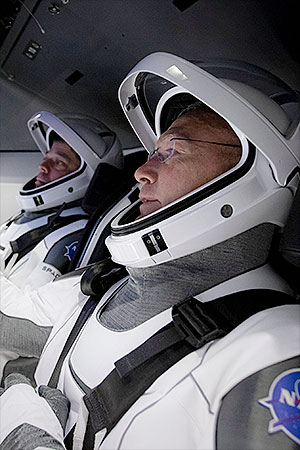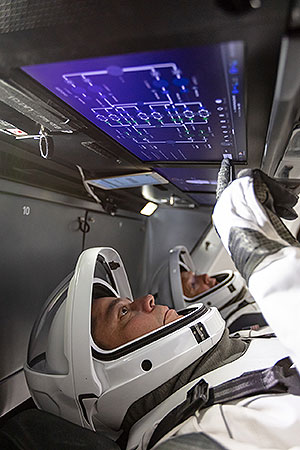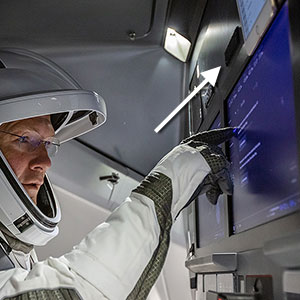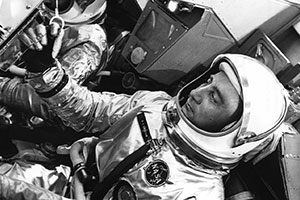May 27, 2020 — NASA's first astronauts to launch into space asked for a window.
As chronicled in "The Right Stuff," Tom Wolfe's classic book about the rise of the U.S. human spaceflight program, the nation's original astronauts insisted that a window be added to their Mercury capsules. Their demand was later dramatized in the film adaptation.
"Uh, where you are planning on putting the window?" astronaut Gordon Cooper (Dennis Quaid) asks the engineers in a memorable scene from the 1983 movie.
"We want a window," Alan Shepard (Scott Glenn) states in no uncertain terms.
Almost 60 years after the (real-life) Mercury astronauts got their window, a new NASA crew is set to launch on a new type of capsule again. This spacecraft already had windows as part of its initial design, but even had it not, astronauts Bob Behnken and Doug Hurley were careful about what requests they made to customize their SpaceX Crew Dragon.
And they had a different cinematic lexicon to borrow from.
"I think for both Doug and I, our goal through this entire process has been to not turn this spacecraft into 'Bob and Doug's excellent machine,'" said Behnken, adapting the title of the 1989 comedy, "Bill & Ted's Excellent Adventure," during a pre-flight press conference for their Demo-2 mission.
21st century spacecraft
"I think you could probably say that every display and ever procedure that is presented to crews in the future is going to have multiple items by both Doug and I that are our inputs and will go forward," Behnken said, replying to a question from collectSPACE. "We are just hoping they cannot see our initials below them."
"We are hoping that they take them as, 'Hey, that seems like a good idea!' and then maybe they'll incorporate [them] and think it was their idea because it was so good," he said.
In development by SpaceX since 2010, the Crew Dragon (or Dragon 2) was first publicly revealed by CEO Elon Musk three years later. From the start, SpaceX said that its first crewed spacecraft was intended to be a new type of transport.
"We wanted to take a big step in technology," said Musk at the Dragon's unveiling, adding they wanted "something that was a step change in spacecraft technology."
"Crew Dragon is a 21st century spacecraft," said Benji Reed, SpaceX's director of crew mission management, at a Demo-2 pre-flight press conference on May 1. "We wanted it to be not only as safe and reliable as you would expect from the most advanced spacecraft in the world, but we also wanted it to look beautiful."
"The control system is a modern feat of engineering," said Reed. "One of the biggest differences that you see from a cockpit [that was] designed many decades ago, where you have many switches and knobs and dials, inside of Dragon you have these large touchscreens."
Behnken and Hurley first joined the SpaceX team as part of NASA's commercial crew "cadre" in 2015, three years before they were assigned as the Demo-2 crew.
"This spacecraft, Crew Dragon, is SpaceX's design from start to finish," said Hurley. "NASA certainly influenced at times, offered opinions, and both Bob and I were in that same boat in regards to operating and flying the vehicle in space. We offered our opinions and suggestions. It was just a huge collaboration."
Personal attachments
That is not the say the Crew Dragon is devoid of all personal touches courtesy of its first astronaut crew.
"There probably are a few pieces of Velcro in the spacecraft we are going to fly that we put there and we will use," Hurley told collectSPACE. "Maybe future crews with their Dragons will use a little bit different Velcro than we."
A carryover from the early days of the space program, Velcro hook and loop fasteners have been used to hold cue cards and checklists in place, secure space food and even keep sleeping astronauts from floating around the cabin.
As veterans of two earlier space shuttle missions each, Hurley and Behnken were familiar with the concept of "crew choice" Velcro as one of the ways that the astronauts customized the orbiters for their use. (Crew choice Velcro was typically yellow in color, distinguishing it from the more permanent light blue attach points that were not removed by technicians between shuttle flights.)
"Bob and I are a little bit 'old school' in that respect and so there is a little bit of Velcro," Hurley admitted. "Hopefully, nothing that takes away how good the vehicle looks."
Avoiding the 'Gusmobile'
After the Mercury astronauts got their window, one of the original seven, Virgil "Gus" Grissom, was assigned to work with McDonnell Aircraft (later, McDonnell Douglas; today, The Boeing Company) on the design of the next U.S. spacecraft, the two-seater Gemini capsule. As the same company had been the contractor responsible for building the Mercury spacecraft, Grissom was already close with the McDonnell engineers.
"So close, in fact, that the cockpits of the first three spacecraft were designed around him, giving him the best view of the instrument panel and out the window," Barton Hacker and James Grinwood described in "On the Shoulders of Titans," NASA's history of the Gemini program.
The Gemini spacecraft was so tailored to Grissom's preferences that it gained a new nickname: the "Gusmobile."
There was a problem, though. At 5 and a half feet tall, Grissom was shorter than many of his fellow NASA astronauts. His own crewmate for the first Gemini flight, John Young, was only two inches taller, but he had to have his seat compressed in order to get into the capsule. Later Gemini crews had to have both their seats and the hatch over their heads adjusted just to fit.
"By July 1963, the program office had discovered that 14 of the 16 astronauts [in the program] could not be fitted into the cabin as designed, and all later cockpits had to be modified," wrote Hacker and Grinwood.
Hurley and Behnken were careful not to make the same mistake with Dragon.
"We have tried very hard not to say, 'I want it this way,' or 'I like it this way,' said Hurley. "In fact, Bob is the one who said we are not going to build the Gusmobile." |
|

Demo-2 crewmates Bob Behnken (at left) and Doug Hurley take part in a full simulation of launch and docking of SpaceX's Crew Dragon spacecraft inside a flight simulator. While learning how to fly the capsule, the two astronauts made suggestions to SpaceX but avoided customizing the Dragon to fit their preferences. (SpaceX)

NASA astronauts Bob Behnken (in foreground) and Doug Hurley familiarized themselves with SpaceX's Crew Dragon over the two years spanning their Demo-2 crew selection and the launch of the mission. (NASA)

The black bar above the touchscreen to the side of the tablet is an example of Velcro as used inside the SpaceX Dragon. (NASA)

One of the original Mercury astronauts, Gus Grissom worked with McDonnell's engineers to develop NASA's Gemini spacecraft. The "Gusmobile" became known as such because of how tailored the capsule was to fit Grissom's own preferences and stature. (NASA) |
